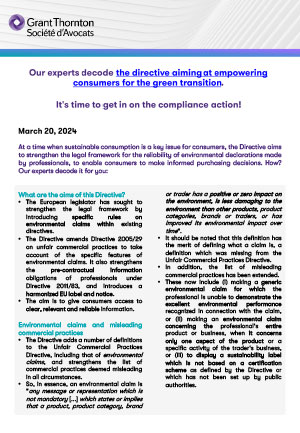At a time when sustainable consumption is a key issue for consumers, the Directive aims to strengthen the legal framework for the reliability of environmental declarations made by professionals, to enable consumers to make informed purchasing decisions. How? Our experts decode it for you:
What are the aims of this Directive?
- The European legislator has sought to strengthen the legal framework by introducing specific rules on environmental claims within existing directives.
- The Directive amends Directive 2005/29 on unfair commercial practices to take account of the specific features of environmental claims. It also strengthens the pre-contractual information obligations of professionals under Directive 2011/83, and introduces a harmonized EU label and notice.
- The aim is to give consumers access to clear, relevant and reliable information.
Environmental claims and misleading commercial practices
- The Directive adds a number of definitions to the Unfair Commercial Practices Directive, including that of environmental claims, and strengthens the list of commercial practices deemed misleading in all circumstances.
- So, in essence, an environmental claim is “any message or representation which is not mandatory [...] which states or implies that a product, product category, brand or trader has a positive or zero impact on the environment, is less damaging to the environment than other products, product categories, brands or traders, or has improved its environmental impact over time”.
- It should be noted that this definition has the merit of defining what a claim is, a definition which was missing from the Unfair Commercial Practices Directive.
- In addition, the list of misleading commercial practices has been extended.
- These now include (i) making a generic environmental claim for which the professional is unable to demonstrate the excellent environmental performance recognized in connection with the claim, or (ii) making an environmental claim concerning the professional’s entire product or business, when it concerns only one aspect of the product or a specific activity of the trader's business, or (iii) to display a sustainability label which is not based on a certification scheme as defined by the Directive or which has not been set up by public authorities.
- The Directive prohibits a number of practices with regard to environmental claims. Does this mean, a contrario, that claims of another kind would not be subject to such strict criteria? In view of the decision-making practice of the Administration and the courts, the answer does not seem obvious to us.
Reinforcement of the pre-contractual information obligation
- The Directive reinforces the pre-contractual information obligation of professionals marketing products, by clarifying Directive 2011/83 on consumer rights.
- These include the notion of reparability score, defined as “a score expressing the ability of a good to be repaired based on harmonised requirements established at Union level”, which must be communicated to the consumer, as well as an obligation to provide information on the minimum period of availability of updates supplied for digital content and services.
- In addition, the Directive now requires the trader to inform the consumer, prior to the conclusion of the contract, in particular of the existence and duration of the commercial guarantee of durability by means of a harmonized label if it is proposed by the producer, or of its absence for energy-consuming goods.
- In addition, noting that consumers are often unaware of their rights under Directive 2019/771, the European legislator has introduced, as part of the Directive, a harmonized notice designed to remind consumers of the existence of the legal warranty of conformity, its two-year duration and the fact that a longer duration may be provided for under national law.
- Sellers must therefore ensure that they provide this information, and in particular display the label and instructions prior to concluding a contract with the consumer for the products concerned.
What form should this harmonized label and notice take?
- According to the Directive, the harmonized notice and label must be easily recognizable and understandable for consumers, and easy to use and reproduce for traders.
- With this in mind, the harmonized notice should be prominently displayed, on an eye-catching poster on a store wall or next to the checkout or, if the product is sold online, as a general reminder on the website of the professional selling the goods.
- As for the label, it should be clearly visible and used in such a way as to enable consumers to easily identify the specific good benefiting from a commercial guarantee of durability, for example by affixing the label directly to the product packaging, or by prominently displaying it on the shelf, or directly next to the product image in the case of online sales.
- In any case, the Commission has until September 27, 2025 to specify, by means of implementing acts, the layout and content of this notice and label.
- You'll need to adapt your display!
What are the penalties?
- The Directive refers to national law on this point.
- Misleading commercial practices are punishable under French law by a criminal fine of up to 1.5 million euros for a legal entity (art. L.132-2 Code de la consommation).
- Failure to comply with the contractual information obligation is punishable by an administrative fine of up to 15,000 euros for a legal entity (art. L.131-1 of the French Consumer Code).
Entry into force of the Directive's provisions
- The directive enters into force on the twentieth day following that of its publication in the Official Journal of the European Union.
- Member States have until March 27, 2026 to transpose the Directive.
What are the next steps?
- Are you a producer or seller?
- Check that your processes are in line with these new requirements and, if necessary, involve the legal and operational teams in their improvements.
- Train legal and operational teams in new environmental claims requirements.
- Anticipate the introduction of harmonized notices and labels.
- Do you have a label or are you a labeling organization?
- Check that the label complies with the certification requirements of the Directive.


























